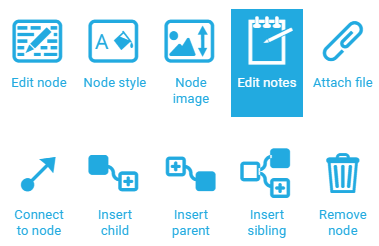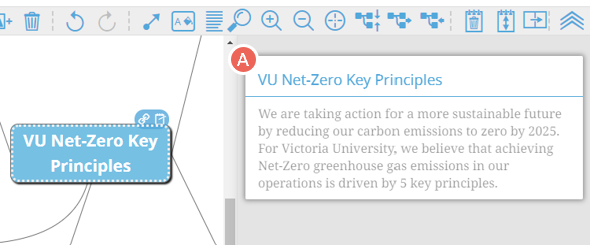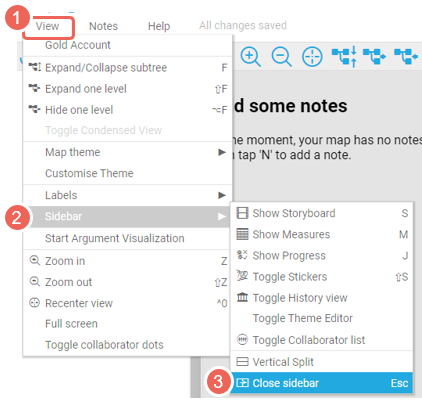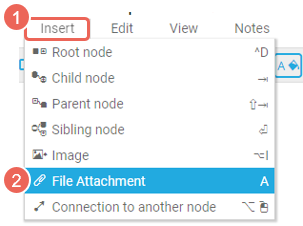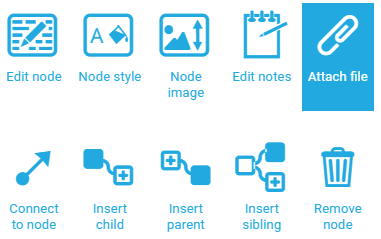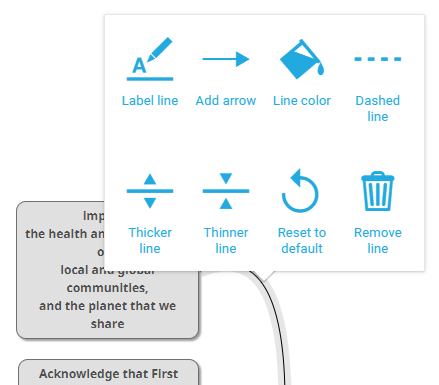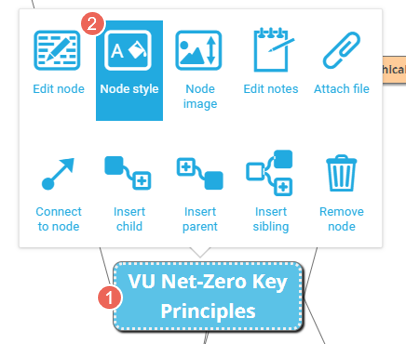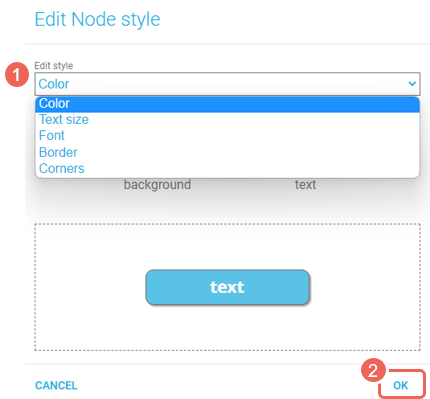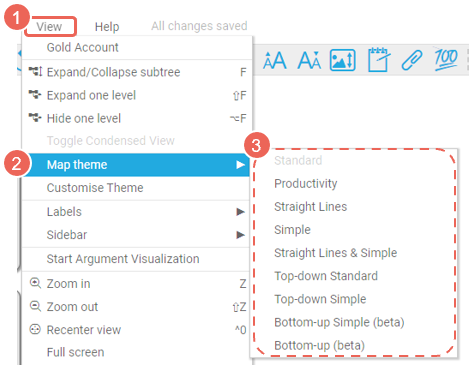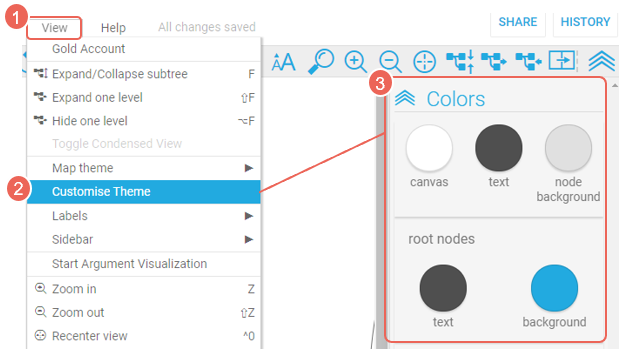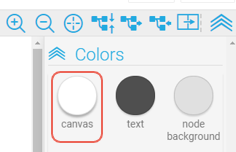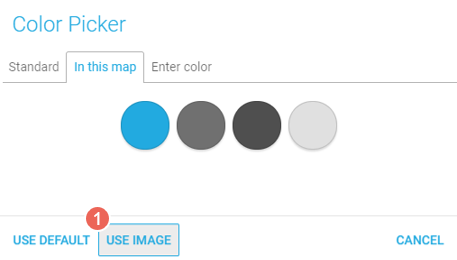Using MindMup
MindMup is a mind-mapping tool that can be accessed from VU Collaborate.
What is a MindMap?
A mind map is a diagram of visually organised information. Mind maps show hierarchical relationships among pieces of the whole. Often a single concept/image is drawn in the centre of a page. Then branching out from the central concept, topics and subtopics are added. Images, words, symbols and colour are added to each idea to help organise ideas, and create associations with the central concept.
While mind maps can be drawn on paper, the major downside is that they can be very time-consuming. With Mind Mup, the creation process can be sped up, by using keyboard shortcuts, and adding node, lines and images rather than drawing them. The finished Mind Mup can then be easily converted to a PDF or PowerPoint document or shared online.
Step One: Sign in to Mind Mup
1. Access Mind Mup
- From a VU Collaborate space from the nav bar,
select Tools, then Mind Mapping Tool.
From the pop-up window, select the link to the Login Page - Or go directly to the Mind Mup Gold login
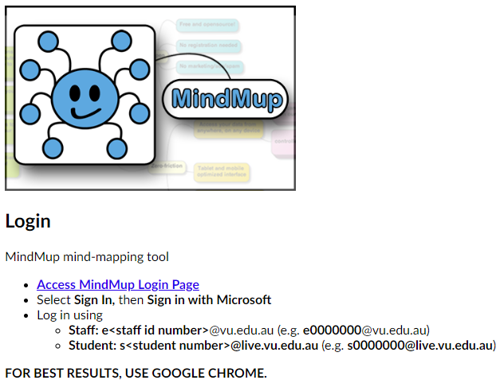
2. Sign in
- Click Sign In, then Sign In with Microsoft.
- Log in using your staff id@vu.edu.au (e.g. e1234567@vu.edu.au) and password.
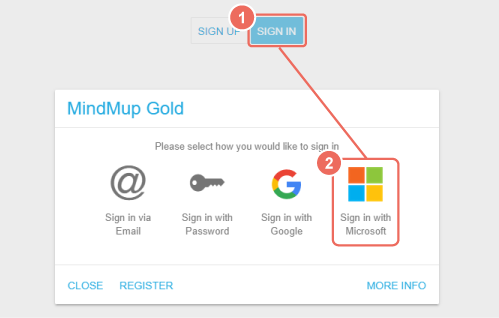
The MindMup Dashboard is where you can create new maps, and access previously created maps.
- To create a new map, select create new map from the menu bar.

- When viewing a map, select the MindMup logo to return to the dashboard.
Step Two: Creating Your Mind Map
To create your mindmap, identify the items below:
- Create the Central Topic
- Brainstorm and create Sub-Topics
- Create relationships between topics and/or sub-topics
Create the Central Topic
The Central Topic is the main concept or idea to be explored. New Mind Maps start with a default Central Topic or Root Node.
1. To edit press the Space bar or double-click on the node and then enter a word or short description.

Brainstorm and create Sub-Topics
Now that you have your main topic (or root node), you can begin to insert your sub-topics (or child nodes).
2. Select the root node then add a child node from (a) the menu bar, (b) node options, or (c) via a keyboard shortcut.
- (a) Menu bar - select Insert Child Node icon
- (b) Node options - right-click, then select Insert Child
- (c) Keyboard shortcut - select Tab key.
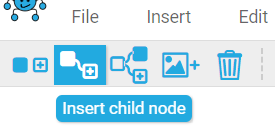
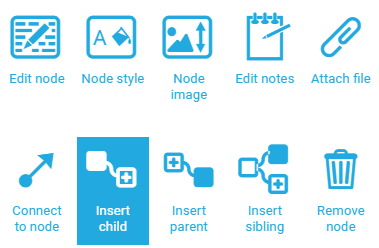
3. You've got your first child node in, now let's give it some siblings.
Select the root node then add a sibling node, from (a) the menu bar, (b) node options, or (c) via a keyboard shortcut
- (a) Menu bar - select the Insert Sibling Node button.
- (b) Node options - right-click, then select Insert Sibling.
- (c) Keyboard Shortcut - press Enter key.
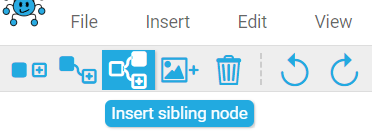
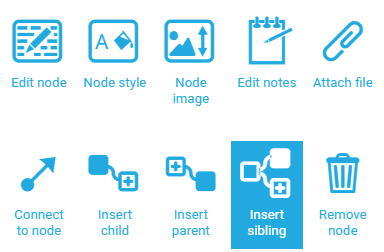
4. To Insert an Image into your mind map, select the Insert Child Image Node from the menubar.

5. After you have inserted an image into a node, double-click the image to add text to it.
6. To change the size or appearance of your image, from (a) the menu bar, (b) node options, or (c) via a keyboard shortcut
- (a) Menu bar - click on your image node and then click Adjust Node Image from the top menu bar.
- (b) Node options - right-click on the node and select Node Image.
- (c) Keyboard Shortcut - select I key.

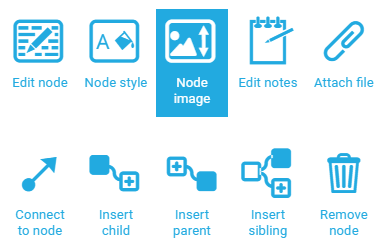
7. Adjust your images
- Width and Height (1), ensuring the Keep Aspect Ratio is selected to prevent your image from becoming distorted.
- Position (2) in relation to the text around it.
Once you are happy with your changes, select Save (3).
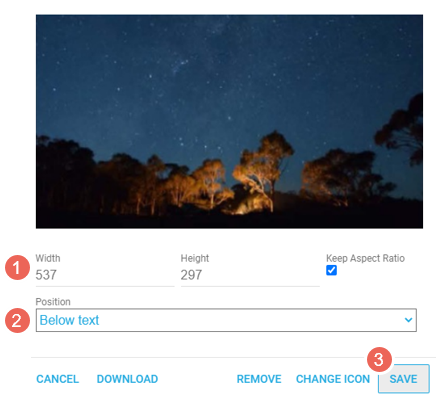
8. You can also add an image to a node that has previously been created. Simply right-click the node you want to add an image to and select the Adjust Node Image button.
From the pop-up window, locate your image. Once added you will get the same insert window as above.
9. To remove a node, select the node to be deleted, then
- (a) Menu bar - select Bin icon, or
- (b) Node options - right-click then select Remove Node.
- (b) Keyboard Shortcut - select Del/Delete key.
![]()
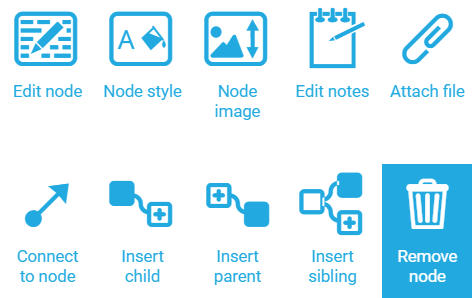
Create relationships between topics and/or sub-topics
After adding a topic (root node) and its sub-topics (or child nodes), you can create a relationship between:
- topic to topic
- subtopic to another sub-topic
by creating a link between nodes.
10. First step, identify where the node relationship should start and end.
For example, the relationship starts from (a) and ends with (b) in the screenshot below.
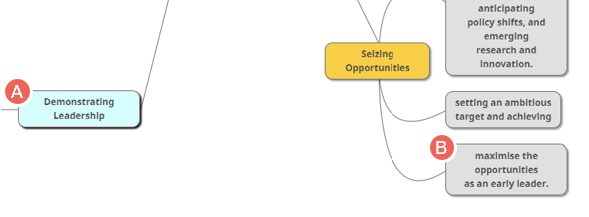
11. Select the node where the relationship should start (a).
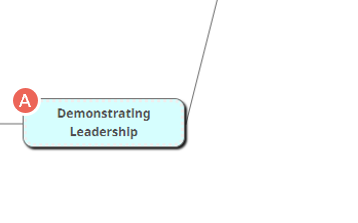
12. Then connect to another node from (a) the menu bar, (b) node options, or (c) keyboard shortcut.
- (a) Menu bar - select Connect to another node from the top menu bar.
- (b) Node options - right-click on the node and select Connect to node.
- (c) Keyboard Shortcut - hold the Alt key and click on the nodes.
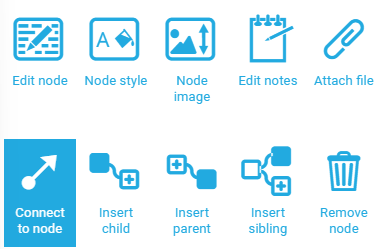
13. Select the node where the relationship should end (b).
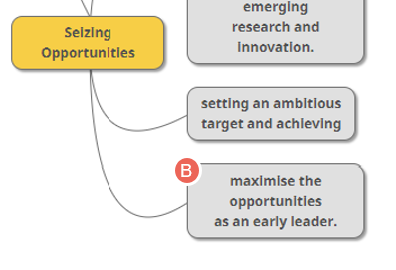
Here is an example of a node relationship:

Other useful menu buttons:
![]() Undo/Redo.
Undo/Redo.![]() Left/Centre/Right alignment of text.
Left/Centre/Right alignment of text.![]() Increase/Decrease node font size.
Increase/Decrease node font size.![]() Zoom in/out or center mind map
Zoom in/out or center mind map
Here is an example of a mind map that demonstrated VU Net Zero Key Principles (2021):
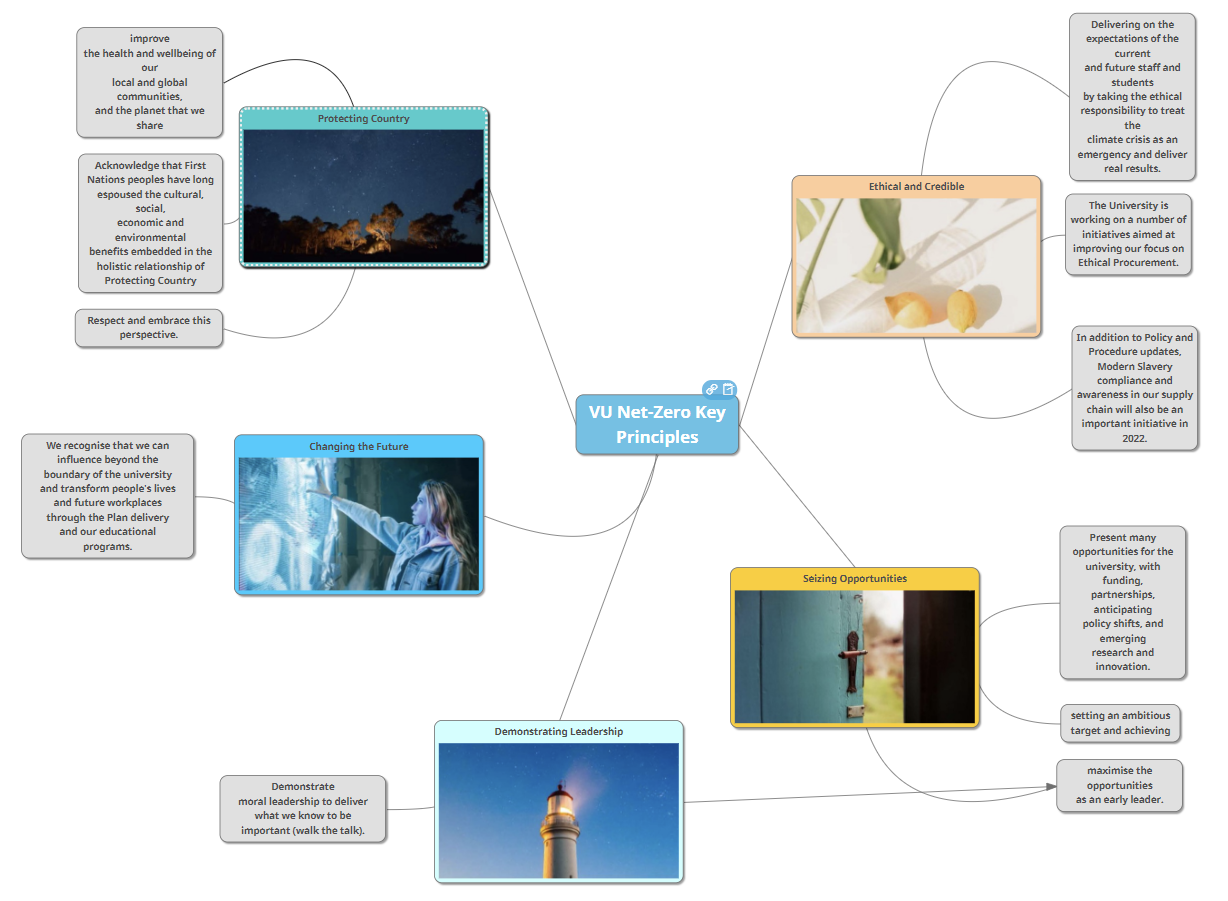
Step Three: Customising your Mind Map
Expand each topic tile below for more details.
Step Four: Downloading and Sharing Mind Maps
- Download
- Publish
- Share
Download
To download your Mindmap, From File tab, select Download As. Then, choose the desired file extension from the list.
- Image (SVG, JPG, PNG) - download an image of your mind map
- PDF - download an image of your mind map displayed within a PDF document
- Outline - download as a text document, and tick Included Text Notes, to include notes.
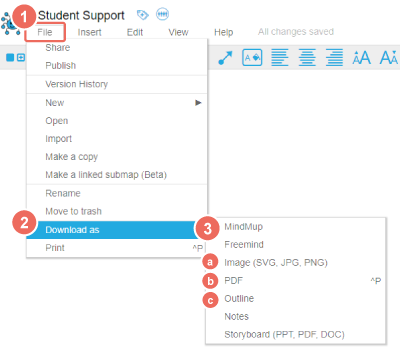
Publish
1. To publish your mindmap, from File (1), select Publish (2)
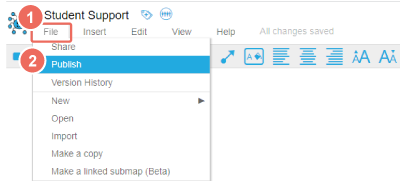
2. Review and make necessary edits to the title, description, and URL slug (1) then click Publish (2).
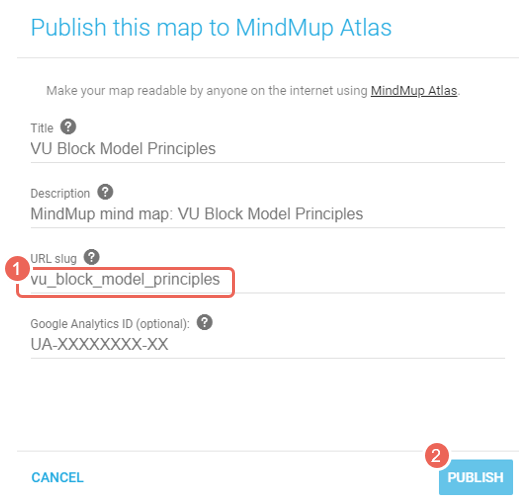
3. Once the mind map is published, you can share it on social networking sites (1), send a link (2), or embed (3) it into your website or blog.
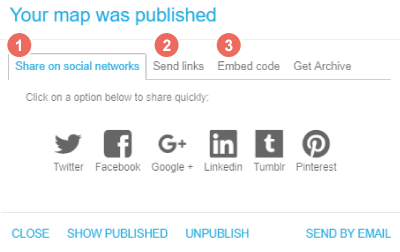
Share
1. To share access to a mindmap. From File, select Share
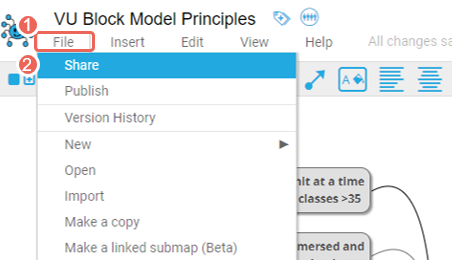
2. Enter the email addresses (This email address is being protected from spambots. You need JavaScript enabled to view it.) to grant share access.
Click the dropdown and change the access to 'View Only' or 'View and Edit' as needed.
3. Then select 'Allow Access.'
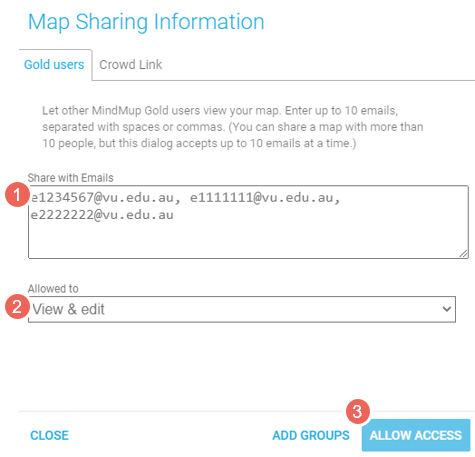
Note: Always use This email address is being protected from spambots. You need JavaScript enabled to view it. like in the screenshot above to share your mindmap with another VU staff member. You can enter up to 10 emails, seperate with spaces or commas.
Displaying your Mind Map to students in VU Collaborate
There are different ways of displaying your mindmap to students in VU Collaborate.
Option 1. Provide a link to your mindmap in VU Collaborate.
Option 2. Embed your mindmap in VU Collaborate.
Note: To get the embed code or link to your mindmap, you will have to first publish your mindmap.
Option 3. Upload a .pdf or an image of your mindmap to VU Collaborate.
Note: To learn more about how to add links and upload files in VU Collaborate, refer to the guide on 'Adding content to a module' in VU Collaborate Help site for staff.
Accepting Student Mind Map Submissions
There are several ways students can submit mindmaps as assessment submissions.
Download and submit PDF Document (Mind Map) and/or Word Document (Outline)
To submit the mind map as document(s) to a VU Collaborate dropbox, students will need to
- Download as an image or PDF, and/or
- Download as an outline and tick include text notes to include annotated notes
Publish and submit the URL link
Students can also publish mindmaps, then submit the URL link or embed the mindmap in the HTML editor in the dropbox folder in VU Collaborate.
- Note: Publish maps can be viewed by anyone AND
the URL slug should be updated to include the student number (to keep URLs unique). - Also submitting a PDF and outline (if notes are used) is recommended.
Share and submit the URL link
To submit a URL link to the mindmap, students will need to first share it with the teacher's email (This email address is being protected from spambots. You need JavaScript enabled to view it.).
- Note: mindmaps can only be viewed by people who have been granted share access.
- Also submitting a PDF and outline (if notes are used) is recommended.
To learn about how to create and submit mindmaps in VU Collaborate as a student, please refer to Using Mindmup guide on VU Collaborate student help site.




